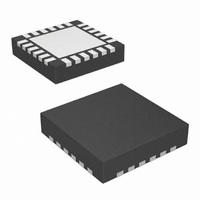SI4313-B1-FM Silicon Laboratories Inc, SI4313-B1-FM Datasheet - Page 20

SI4313-B1-FM
Manufacturer Part Number
SI4313-B1-FM
Description
IC RX FSK 315-915MHZ 20VQFN
Manufacturer
Silicon Laboratories Inc
Series
EZRadio®r
Type
ISM Receiverr
Specifications of SI4313-B1-FM
Package / Case
20-VQFN
Mfg Application Notes
Si4313 Register Desc AppNote
Frequency
315MHz, 434MHz, 868MHz, 915MHz
Sensitivity
-118dBm
Data Rate - Maximum
128kbps
Modulation Or Protocol
FSK, GFSK, OOK
Applications
Data Logging, Health Monitors, Remote Control, Weather Station
Data Interface
PCB, Surface Mount
Antenna Connector
PCB, Surface Mount
Voltage - Supply
1.8 V ~ 3.6 V
Operating Temperature
-40°C ~ 85°C
Operating Frequency
315 MHz to 915 MHz
Operating Supply Voltage
1.8 V to 3.6 V
Maximum Operating Temperature
+ 85 C
Minimum Operating Temperature
- 40 C
Mounting Style
SMD/SMT
Supply Current
100 nA
Lead Free Status / RoHS Status
Lead free / RoHS Compliant
Features
-
Memory Size
-
Current - Receiving
-
Lead Free Status / Rohs Status
Lead free / RoHS Compliant
Other names
336-1980-5
Available stocks
Company
Part Number
Manufacturer
Quantity
Price
Company:
Part Number:
SI4313-B1-FMR
Manufacturer:
TI
Quantity:
10 000
Part Number:
SI4313-B1-FMR
Manufacturer:
SILICON LABS/芯科
Quantity:
20 000
Si4313-B1
3.2.1. SHUTDOWN State
The SHUTDOWN state is the lowest current consumption state of the device with nominally less than 15 nA of
current consumption. The shutdown state may be entered by driving the SDN pin (Pin 20) high. The SDN pin
should be held low in all states except the SHUTDOWN state. In the SHUTDOWN state, the contents of the
registers are lost and there is no SPI access.
When the chip is connected to the power supply, a POR will be initiated after the falling edge of SDN.
3.2.2. IDLE State
There are fivefour different modes in the IDLE state which may be selected by "Register 07h. Operating Mode and
Function Control 1". All modes have a tradeoff between current consumption and response time to TX/RX mode.
This tradeoff is shown in Table 10. After the POR event, SWRESET, or exiting from the SHUTDOWN state the chip
will default to the IDLE-READY mode. After a POR event the interrupt registers must be read to properly enter the
SLEEP, SENSOR, or STANDBY mode and to control the 32 kHz clock correctly.
3.2.2.1. STANDBY Mode
STANDBY mode has the lowest current consumption of the five IDLE states with only the LPLDO enabled to
maintain the register values. In this mode the registers can be accessed in both read and write mode. The
STANDBY mode can be entered by writing 0h to "Register 07h. Operating Mode and Function Control 1". If an
interrupt has occurred (i.e., the nIRQ pin = 0) the interrupt registers must be read to achieve the minimum current
consumption. Additionally, the ADC should not be selected as an input to the GPIO in this mode as it will cause
excess current consumption.
3.2.2.2. SLEEP Mode
In SLEEP mode the LPLDO is enabled along with the Wake-Up-Timer, which can be used to accurately wake-up
the radio at specified intervals. See "8.4. Wake-Up Timer and 32 kHz Clock Source" on page 36 for more
information on the Wake-Up-Timer. SLEEP mode is entered by setting enwt = 1 (40h) in "Register 07h. Operating
Mode and Function Control 1". If an interrupt has occurred (i.e., the nIRQ pin = 0) the interrupt registers must be
read to achieve the minimum current consumption. Also, the ADC should not be selected as an input to the GPIO
in this mode as it will cause excess current consumption.
3.2.2.3. SENSOR Mode
In SENSOR mode the Low Battery Detector may be enabled in addition to the LPLDO and Wake-Up-Timer. The
Low Battery Detector can be enabled by setting enlbd = 1 in "Register 07h. Operating Mode and Function Control
1". See "8.3. Low Battery Detector" on page 34 for more information on this feature. If an interrupt has occurred
(i.e., the nIRQ pin = 0) the interrupt registers must be read to achieve the minimum current consumption.
3.2.2.4. READY Mode
READY Mode is designed to give a fast transition time to TXRX mode with reasonable current consumption. In this
mode the Crystal oscillator remains enabled reducing the time required to switch to TX or RX mode by eliminating
the crystal start-up time. READY mode is entered by setting xton = 1 in "Register 07h. Operating Mode and
Function Control 1". To achieve the lowest current consumption state the crystal oscillator buffer should be
disabled in “Register 62h. Crystal Oscillator Control and Test.” To exit READY mode, bufovr (bit 1) of this register
must be set back to 0.
3.2.2.5. TUNE Mode
In TUNE mode the PLL remains enabled in addition to the other blocks enabled in the IDLE modes. This will give
the fastest response to TXRX mode as the PLL will remain locked but it results in the highest current consumption.
This mode of operation is designed for frequency hopping spread spectrum systems (FHSS). TUNE mode is
entered by setting pllon = 1 in "Register 07h. Operating Mode and Function Control 1". It is not necessary to set
xton to 1 for this mode, the internal state machine automatically enables the crystal oscillator.
20
Rev. 1.0











